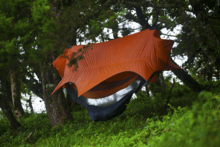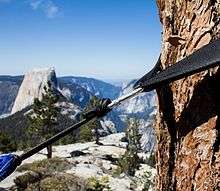Hammock camping

Hammock camping is a form of camping in which a camper sleeps in a suspended hammock rather than a conventional tent on the ground. Due to the absence of poles and the reduced amount of material used, they tend to be significantly lighter than a tent. Their reduced weight often results in less space inside than a similar occupancy tent. In foul weather, a tarp is suspended above the hammock to keep the rain off of the camper. Mosquito netting, sometimes integrated into the camping hammock itself, is also used as climatic conditions warrant. Camping hammocks are used by campers who are looking lighter weight, and protection from ground-dwelling insects or other ground complications. This can include sloped ground, rocky terrain and flooded terrain.[1]
History

The hammock was developed in Pre-Columbian Latin America and continues to be produced widely throughout the region, among the Urarina of the Peruvian Amazon, for several years in Ghana,[2] and presently throughout North America, Europe, and Australia. The origin of the hammock remains unknown, though many maintain that it was created out of tradition and need. The word hammock comes from hamaca, a Taino Indian word which means 'thrown fishing net'. On long fishing trips, the Taíno would sleep in their nets, safe from snakes and other dangerous creatures.
Appeal of hammock camping
The primary appeal of hammock camping for most users is comfort and better sleep, as compared to sleeping on a pad on the ground. Hammock camping enthusiasts argue that hammocks don't harm the environment in the way that conventional tents do. Most hammocks attach to trees via removable webbing straps, or "tree-huggers," which don't damage the bark and leave little or no marks afterward. Whereas it's easy to see a frequently used campground because of the effect on the grass, scrub and topsoil, the presence of a hammock camping site is much harder to detect. This has found favour with hikers and campers who follow the principles of Leave No Trace camping. Hammock camping also opens up many more sites for campers - stony ground, slopes, and so on - as well as keeping them off the ground and away from small mammals, reptiles and insects. Sleeping off the ground also keeps the camper out of any rainwater runoff that might seep in under a tent during a downpour. Lastly, the relatively light weight of hammocks makes them ideal for reducing backpack weight, thereby making it a good option for ultralight backpacking enthusiasts.

One of the benefits of hammock camping, however, can also be a significant drawback. A suspended hammock allows for a cooling air flow to surround the camper in hot weather but that also makes it harder to stay warm when temperatures plummet either during the evening or seasonally as a sleeping bag will be compressed under a camper's weight, reducing its ability to trap air and provide insulation. When deciding to commit to hammock camping most "hangers" ditch their sleeping bags for down filled or synthetic quilts. The quilts are divided into two different types, top quilts (TQ) and under quilts (UQ). The UQ is suspended underneath the hammock so the weight of the hanger doesn't compress the baffles thus providing the air pockets for your body to heat and keep you warm. Concurrently the TQ is just a down blanket with some having the option or ability to make a small box for your feet. Essentially, it is just the top half of a sleeping bag. Because a sleeping bags underside is compressed it loses it's insulating properties. A TQ cuts the unnecessary material to save weight and fabric. The TQ/UQ sleep system is not only warm but each quilt packs into the size of a grapefruit or smaller depending on temperature rating. Some hammocks have been designed with an extra layer of fabric,[3][4] or a series of large pockets, on the bottom. Insulating material, such as foam, quilting, aluminum windscreen reflectors,[5] clothes, or even dead leaves and brush from the campsite is stuffed between the bottom layers or inside the bottom pockets to create an insulating buffer between the camper and the cold outside air. While the above solutions, except for the found materials, add weight and bulk to the hammock, some approaches use an ultralight open cell foam with a mylar space blanket to mitigate this increase in weight. Another drawback is that a camping hammock requires two trees close enough to hang it and strong enough to support the sleeper's weight. This can be a limitation depending on what environment a person is camping in and at higher elevations where trees are more sparse. In these situations hammock campers may bring along a light groundsheet and "go to ground" using their hammock as a ground tent.
Suspension systems, tarpaulins, and amenities

One of the unique concepts of hammock camping is the new diversity of suspension systems and add-ons which campers use in making their hammock set-up unique and functional. The line on which the hammock's weight is held is often swapped for a variety of lighter weight suspension made of Dyneema or other UHMWPE material. These reduce both weight and bulk. Many use similar lines formed into a constriction knot (colloquially referred to by the brand name "Whoopie Slings"[6]) for quick adjustment and setup. These may be connected to the webbing straps ("Tree Huggers") using a lightweight toggle or a carabiner, or more uniquely designed connectors such as Dutch Clips or Tri-Glides.
Some hammocks are designed with a dedicated tarpaulin. Others come without a tarpaulin with the understanding the user will want to select the size and style of tarpaulin which best fits their needs. There are many different ways in which hammock campers generally hang their tarpaulin. In some, the tarpaulin is connected to the hammock's suspension line using a system of mitten hooks and plastic connectors. In others the tarpaulin is hung separately using either the hammocks integrated ridge line, or a separate ridge line placed under or even over the tarpaulin.
Some tarps have an asymmetrical pattern which matches the shape of the hammock, but the majority of hammock campers use a hex-shaped tarpaulin, many of which have a catenary shape for strength against wind and reduction in size and weight. The diamond shape tarpaulin is also used by several hammock campers.
Additional amenities for tarpaulins include removable tarpaulin doors (nylon pieces added to the main openings in cold or windy weather). Different designs of tarpaulin line tensioners are sometimes used to keep tarpaulin lines tight.
References
- ↑ "The 7 Ugly Truths About Tents and Why Hammocks Always Win - Serac Hammocks". Serac Hammocks. Retrieved 2016-02-27.
- ↑ Baden-Powell, Sir Robert (2005) [1917]. Young Knights of the Empire. Echo Library. ISBN 1-84637-904-0.
- ↑ "Choosing your hammock". Dream Hammock LLC. Retrieved 8 November 2014.
- ↑ Dixon, Alan. "Hammock Camping – Part II: Types of backpacking hammocks, and spec comparison to ground systems". Andrew Skurka. Retrieved 8 November 2014.
- ↑ Speer, Ed (2003). Hammock Camping: The Complete Guide to Greater Comfort,Convenience and Freedom. Speer Hammocks. ISBN 978-0-9718594-4-9.
- ↑ Hansen, Derek J. (Oct. 2011), The Ultimate Hang (An Illustrated Guide To Hammock Camping) ISBN 1-4662-6368-7
.svg.png)